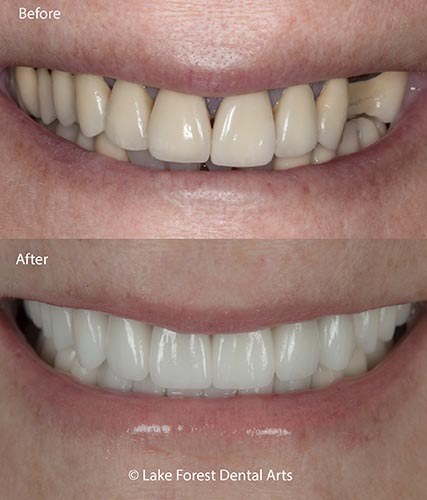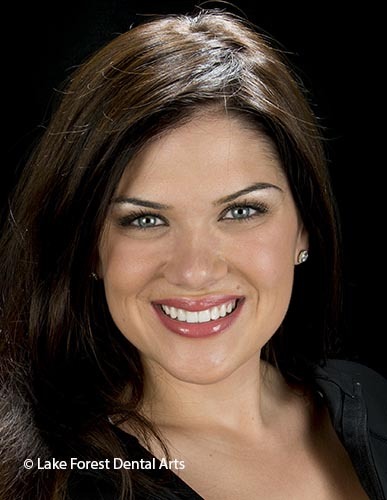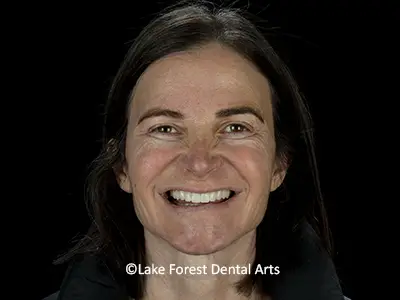Why do I need dental crowns?
Dental crowns or caps are coverings that a dentist can put over a natural tooth. These restorations are one of the most common things dentists do. These restorations are made to restore everything that is broken or damaged. They are done when teeth have lost about 50% of their original volume to decay, old fillings, or other damage. They fully encase or cover the visible portion of the damaged tooth. This is because what remains is so weak that if a new filling were placed it would be too weak and prone to fracture. They replace all that is missing and make everything stronger and can make it look better.
The procedure and materials used to make a cap can be relatively expensive. These restorations are custom made for fit and shape. They can be made of many different materials. The most common types are made of all porcelain, porcelain fused to metal, and metal or gold.
Uses of Dental Crowns:

Old dental caps were replaced with new style versions
- There are many situations that require caps. The following are the most common:
- When there is decay or a missing section that is too large to be replaced with a filling
- The teeth are worn down, cracked a cusp off, or have erosion at the gum line
- When there is weakness after a root canal has been done from being hollowed out
- To improve your smile by changing the shapes or covering blemishes. This is more commonly done with veneers unless the tooth has been heavily restored.
- Most implants are restored by screwing a cap into them.
Why can’t I just get a filling?
Of course you can get a big filling. Some patients insist on it. The fact is that most are back in soon after. The large filling isn’t strong enough for most situations when the majority of the tooth is artificial. Unfortunately, more tooth structure is lost when trying to take this short cut. It also wastes money in the long term. In some situations, you risk the loss of the tooth. How do I know for sure? Ask your dentist.
Types of Dental Crowns
There are several types of crowns. The American Dental Association suggests that there are pros and cons for each type. Your dentist will assess your specific dental situation and recommend which is best for you.
All Porcelain

Tooth crowns can transform a smile.
All porcelain crowns are usually the prettiest type. Porcelain has been developed that has the same optical characteristics as natural tooth enamel. The wear characteristics of porcelain has also been developed to roughly match enamel. This way they are not abusive to the opposing tooth. Ceramic is more bio-compatible than most metals used for other types of caps and the bone and gum tissue tends to be happier and healthier. All-porcelain crowns can be used for both front and back of the mouth.
PFM
This is the most commonly done crown on the market today. Porcelain fused to metal crowns can be quite beautiful. A PFM has a metallic substructure that seals and protects the tooth underneath. Tooth colored porcelain is baked on top of the metal to give it a natural appearance. Next to all-porcelain versions, PFMs are the most natural. Due to the metal support, they are generally stronger than all porcelain crowns.
Metal
Metal crowns are virtually indestructible. They are used when the patient is really hard on their teeth. Many people have bad habits like chewing ice or they grind and clench their teeth. Metal caps are recommended under these situations. Many metal alloys are used to make these restorations. A higher quality office will use gold as the metal choice. Gold is the most bio-compatible of the metals and usually fits better. These are the least attractive caps and are usually used only in the back of the mouth.
Which type is best for me?
Well, it depends on the situation. How does the dentist decide which types of dental crowns to use? Your dentist will consider many factors, such as:
Tooth location and function
A front tooth takes less biting pressure than a back tooth. It is more important for it to look beautiful. An all porcelain version is often the choice for front teeth. A PFM is more commonly picked for back teeth. If the patient bruxes or grinds, then a metal cap might be placed on the last molar.
Is the crown supported by dental implants?
Dental implants are anchored solidly into the bone. There is no shock absorption for the restoration anchored to the implant. A natural tooth has flex to it and the root is held within the socket by ligaments that will stretch. Implants DO NOT BEND OR STRETCH. Implant crowns take heavy loads and need to be very strong. Usually, PFMs or zirconium ceramic crowns are the best choice.
The patient’s preference
Yes, we actually try to please our patients. If our patient asks for a specific type of restoration, we give it to them.
Dental crown procedure | How are they installed?

This beautiful smile was enhanced with 10 dental crowns
When a dentist does a dental crown for you, there are several steps involved. Normally, it takes 2 dental visits to finish it.
Preparation of the tooth
The entire area near the tooth is numbed first. The thickness of the restoration is 1mm around the sides and 2 mm on the top. The tooth needs to be reduced this much to make room for the restoration. We don’t want the newly restored tooth to be any bigger than the original. Decay and any old filling material that is weak are then removed. Some dentists will build up the tooth if more support is needed.
Impression
The dentist will then take an impression of the tooth. The impression can be made from a mold or by a digital scanner. This impression is sent to a dental laboratory.
Temporary crown
There is typically a waiting period of 2-6 weeks for the lab to make your new restoration. During that period you will wear a temporary cap made by your dentist. Some dentists use stock temporaries and others will make custom fitting ones.
Temporaries have two very important roles. They protect the tooth and act as a space maintainer for the other teeth. Teeth can move on their own in a day. The adjacent teeth and those above need to be held in place. The temporaries will prevent migration of the other teeth. A well-made temporary will feel just like the original healthy tooth. Occasionally there is sensitivity with stock temporaries due to leakage.
Temporaries are made to be temporary. Normal chewing and brushing is fine but do not chew sticky stuff like gummy bears. If temps fall out, you must come in to have them re-cemented.
Receiving your new crown
The permanent crown is color matched to the natural teeth. When it comes back to your dentist, a special cement will be used to attach it. When the cement dries, it is firmly and permanently attached to the tooth.
Do dental crowns last forever?
The lifespan of your cap depends on how well you take care of it. People who chew ice or brux will not get the same service life from their restorations. Wearing a night guard if you grind your teeth at night will help. If you neglect good oral care habits such as brushing and flossing, you are more likely to get decay under the crown. The average cap lasts about 10 years but if it is high quality and you take good care of it, you can expect 20+ years of service.
Drs. Fulreader and Fondriest are Nationally recognized and highly sought after cosmetic dentists serving clients from throughout the United States
